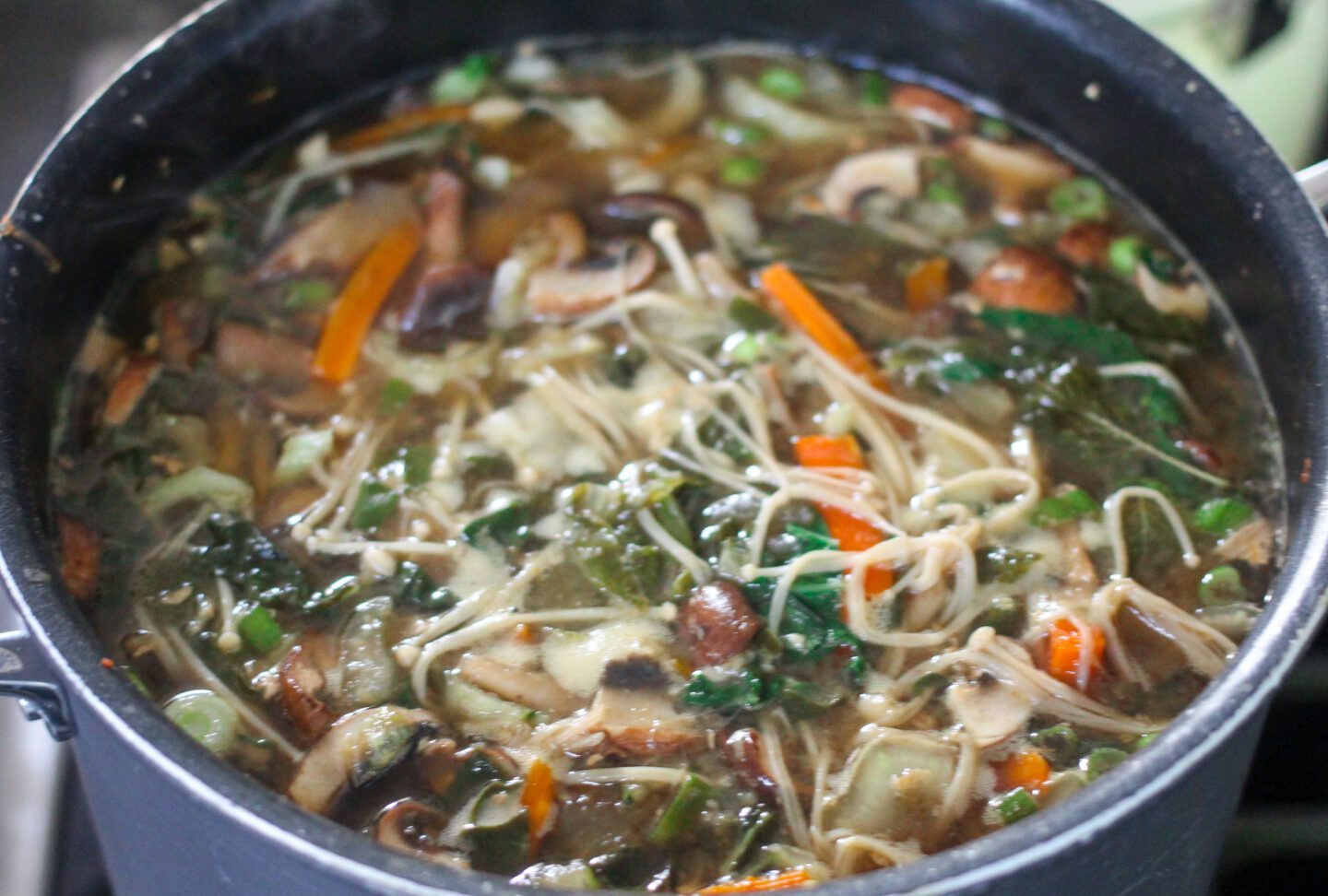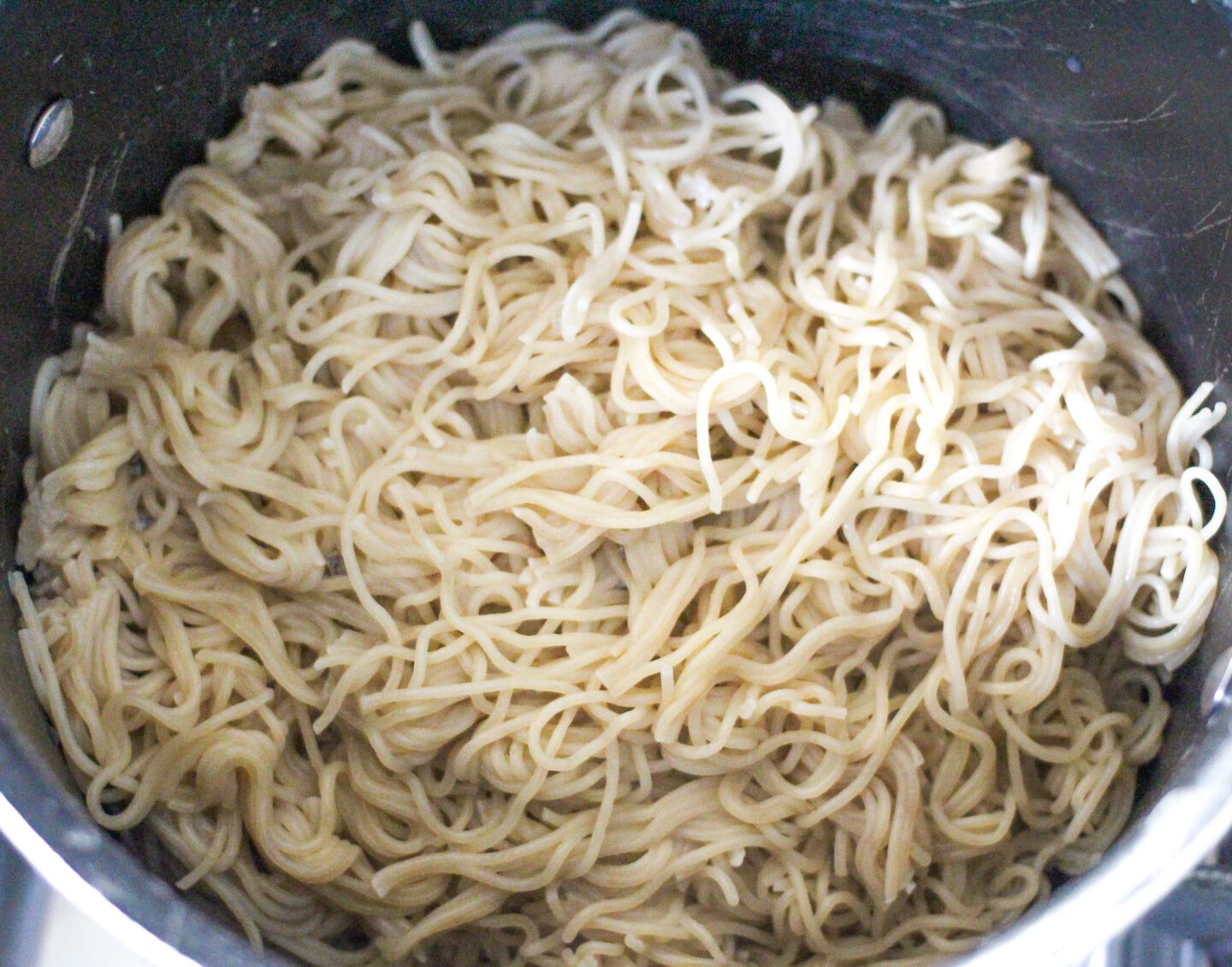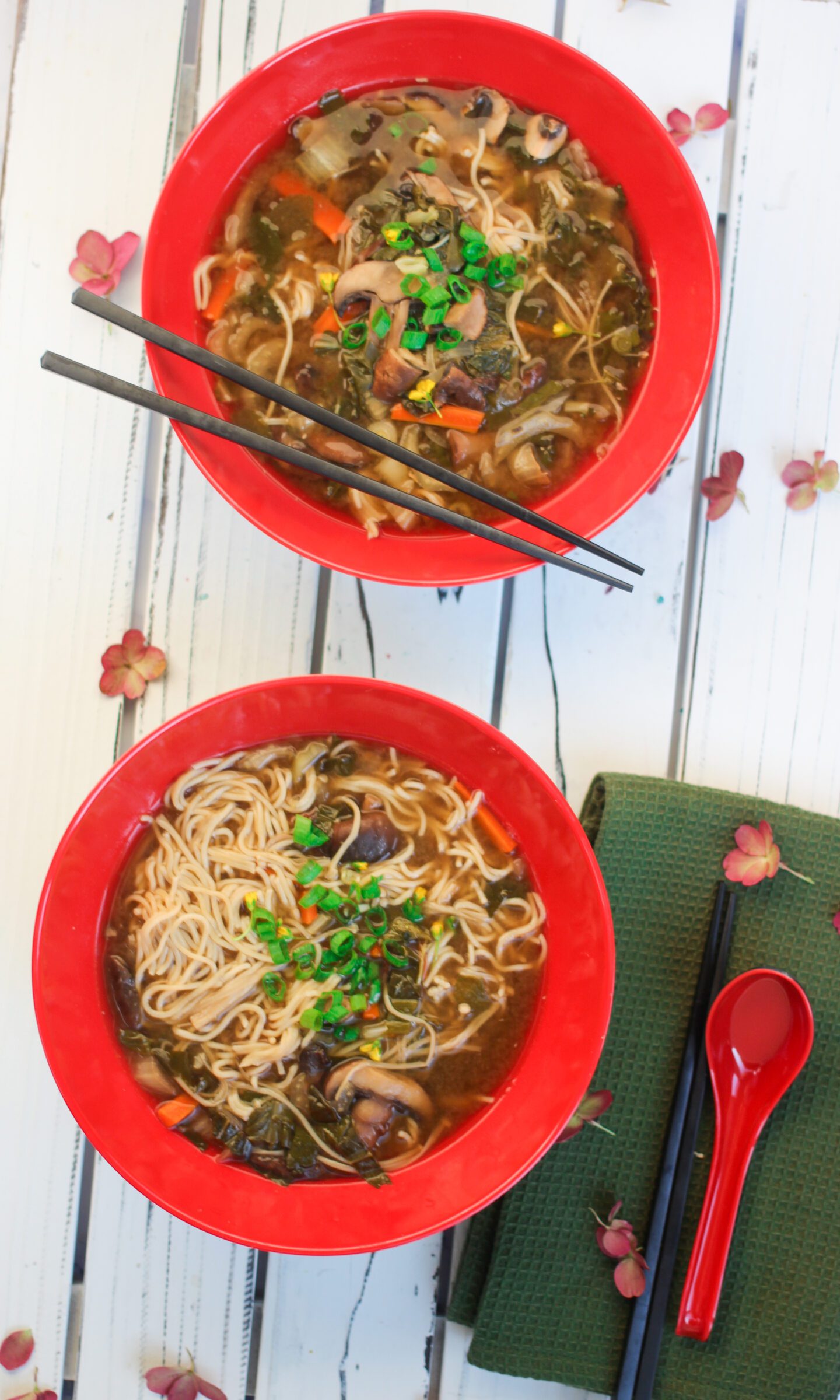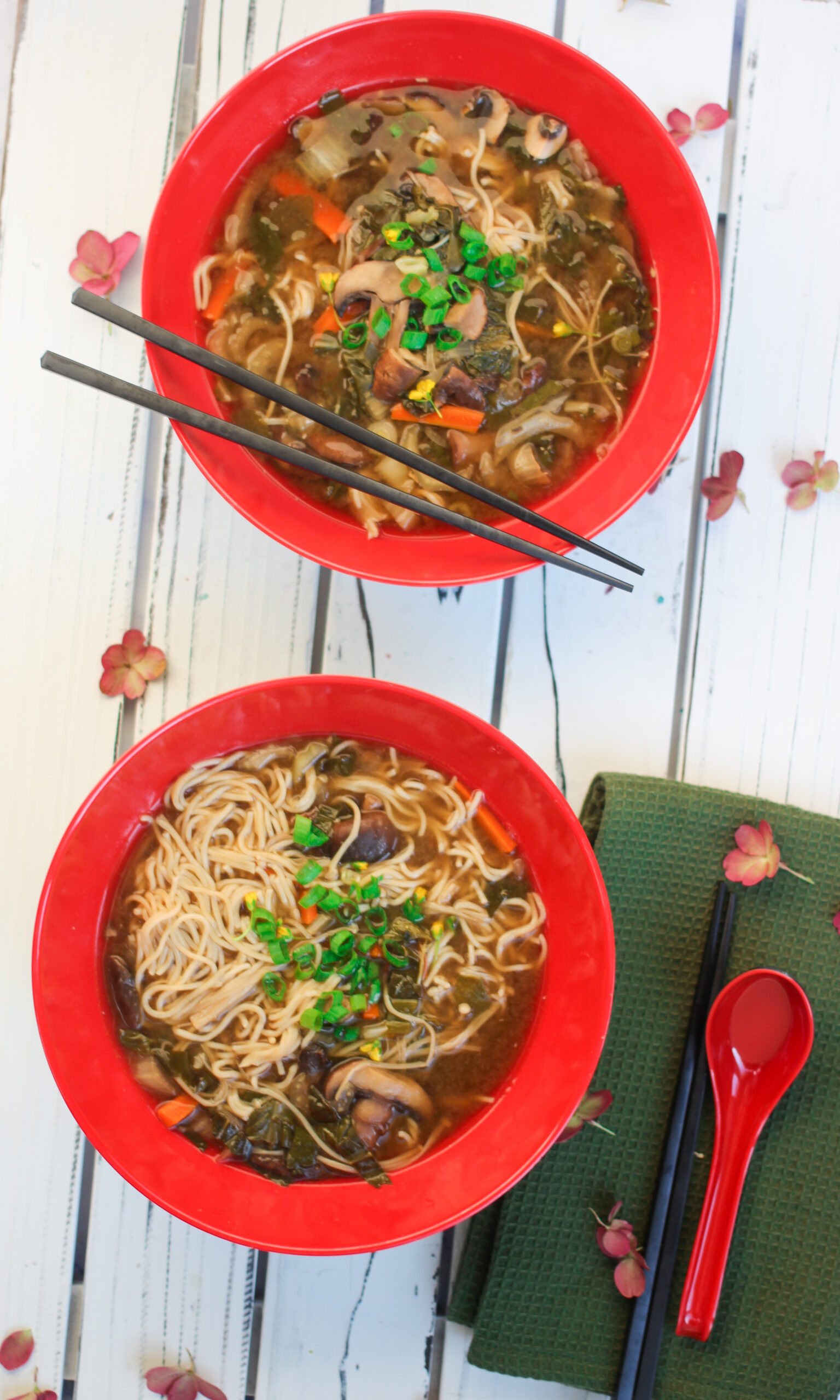
Almost everyone loves a good ramen because it’s a satisfying, soul-warming soup. This Mushroom Miso Ramen has a rich full-bodied mushroom, miso broth full of umami flavor with delicious vegetables and tofu. Using rice noodles makes this hearty plant based soup, gluten-free. You can make the broth ahead of time and enjoy individual servings throughout the week or double the recipe so you have leftovers.

Ingredients for Mushroom Miso Ramen
Flavor builders:
- dark miso paste
- mushroom broth
- soya sauce or tamari (to be gluten-free)
- rice wine vinegar
- garlic
- ginger
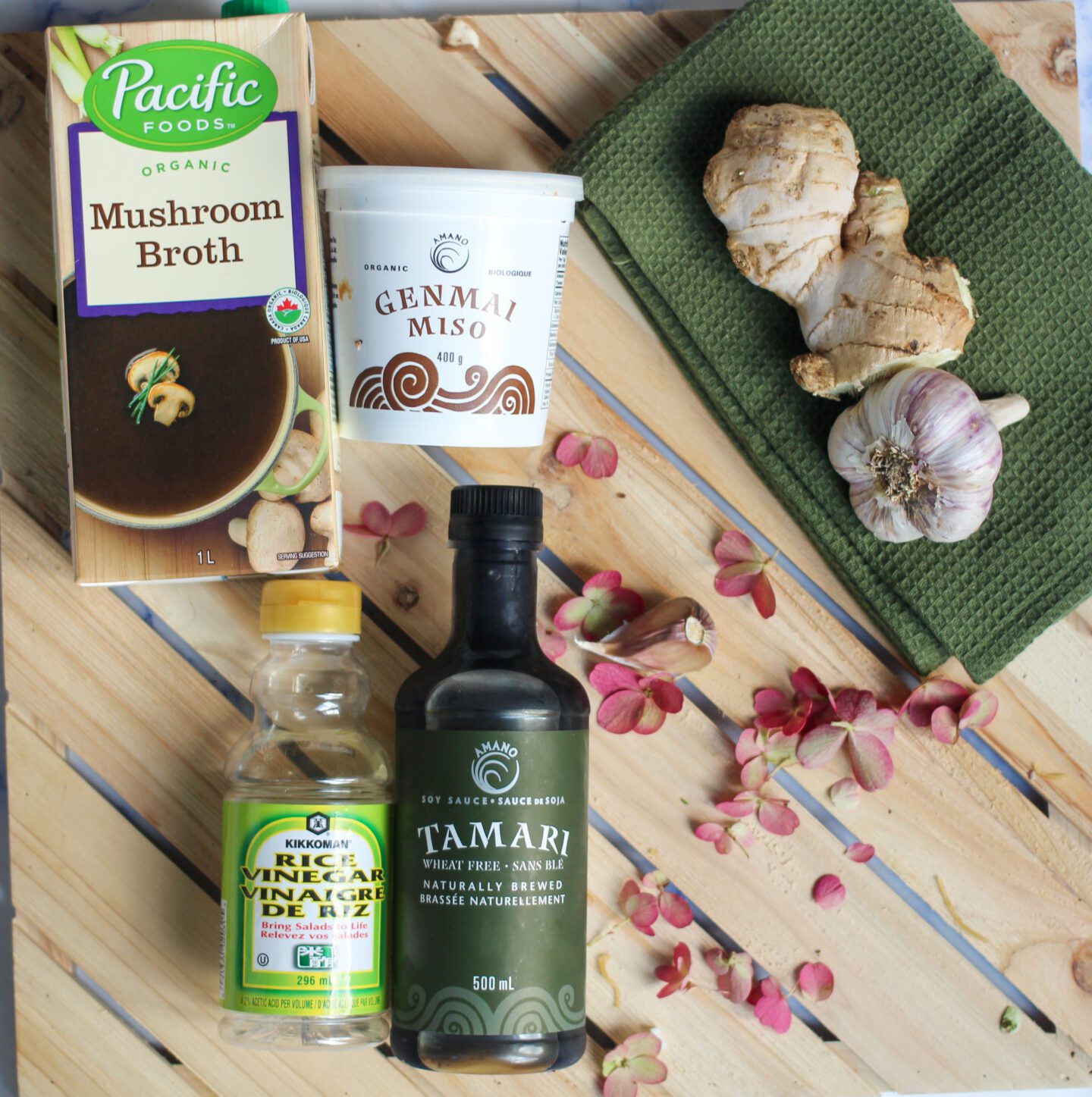
Vegetables:
- onions
- carrots
- bok choy
- mushrooms
- lemon balm or a squeeze of lemon
- green onion and edible flowers for garnish
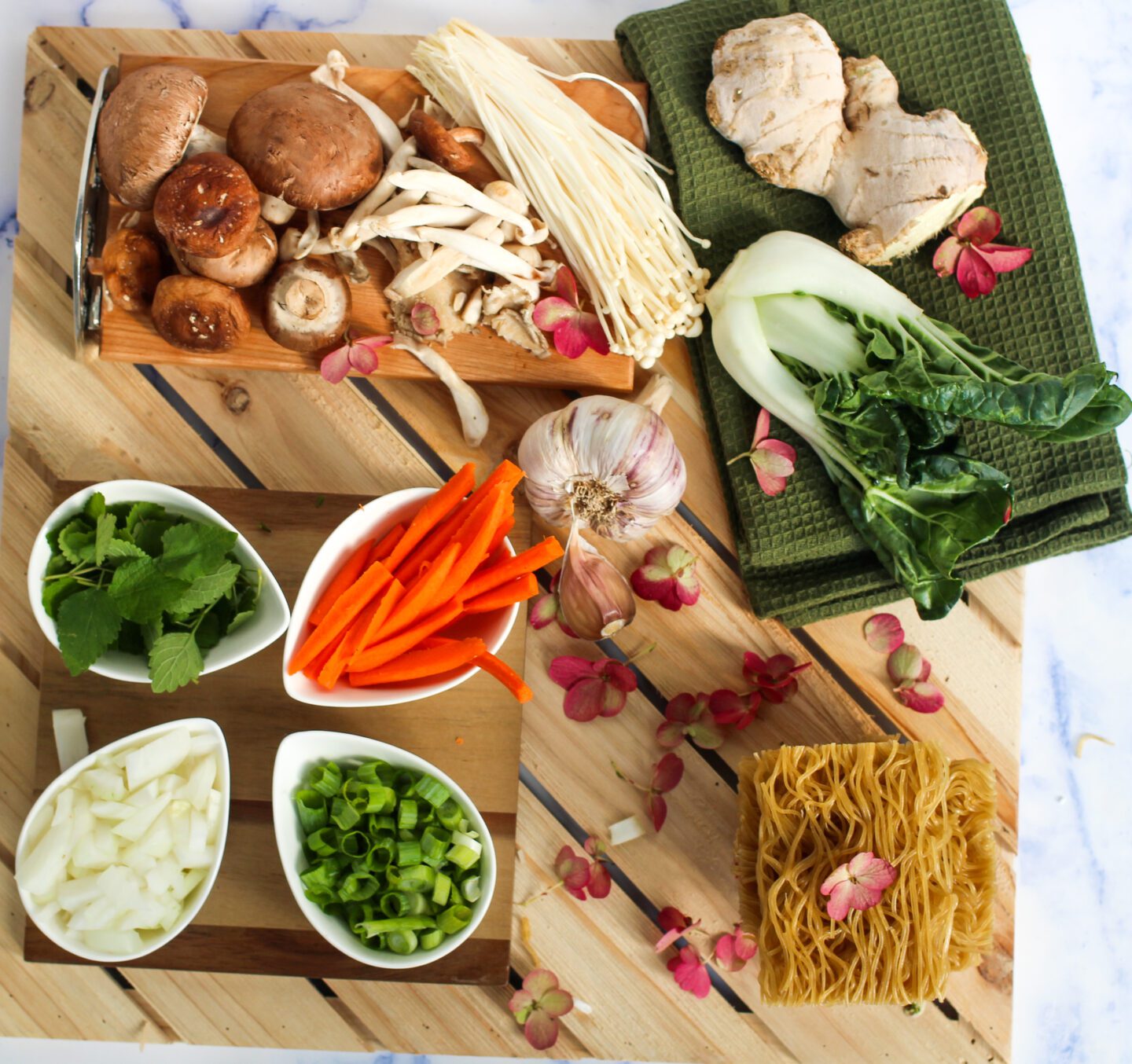
Extras:
Steps To Make It
Ramen broth can be made in many different ways. To keep it vegan and flavorful I use a mushroom broth. You can use store bought or make your own. It is up to you.
- Sauté mushrooms, onions, ginger and garlic in a large thick bottom soup pot.
- Add broth to pot with mirin (rice wine vinegar), soya sauce or tamari.
- Add vegetables except green onion.
- Simmer for 30 minutes to 1 hour.
- Turn off heat and stir in miso.
- Taste and adjust the seasoning if necessary.
- Meanwhile cook noodles separately according to package directions.
- Divide the noodles into ramen bowls. These are the ones I use.
- Top with miso mushroom broth and vegetables.
What is Miso?
Miso is a fermented soybean paste from Japan used as seasoning throughout Asian cuisine. Miso soup may be its most familiar application, but it makes an appearance in everything from salad dressings to pickles and marinades and even caramel sauces. It is even one of the crucial components of soy sauce. The history of miso can be traced to its ancient Chinese counterpart, soybean jiang, one variation in a genre of thick pastes known as jiang.
What Does Miso Taste Like?
Miso is the ultimate reference point for the flavor sensation known as umami—the thick paste is deeply savory, with toasty, funky salty-sweet richness. This umami flavor forms of the base of a lot of everyday Japanese cooking.
How Is Miso Made?
Miso paste is made through a two-step fermentation process. First, a grain, typically rice or barley, but sometimes soybeans, is combined with a mold called Aspergillus oryzae to create koji. The koji, acting here like enzyme jumper cables, is combined with cooked soybeans, water, and additional salt and allowed to further ferment for up to 18 months, unleashing the effects of yeast and lactic acid. The resulting paste is then ready to use.
Six Common Types Of Miso
The different types of miso are defined by tiny but impactful iterations: not only do flavors, aromas, texture, and color vary seasonally and by region, the choices made during fermentation (duration, temperature, vessel) and seasoning (added salt and koji type) have slightly different outcomes.
- Shiro miso. Also known as white miso, shiro miso is the most commonly produced type of miso. Made with rice, barley, and soybeans, shiro miso is a softer expression of the form, with a mild, sweet taste.
- Kome miso. “Rice miso” is one of the most widely available, and can be found in different colors (white, yellow, and red) that vary in strength and sweetness, with nuances down to whether the soybeans in the paste have been boiled or steamed.
- Aka miso. “Red miso” is aged for longer than shiro miso, which gives it a deeper hue. As the color shifts to a rusty red (sometimes even black), the saltiness deepens and the flavors increases in intensity.
- Awase miso. Meaning “mixed miso,” awase is exactly what it sounds like: a mix of many different misos, allowing for different permutations of flavor between the types.
- Mugi miso.”Barley miso” is made from barley malt. This light yellow miso tends to carry a deeper sweetness than something like red miso, with a more pronounced malty funk.
- Mame miso and Hatcho miso are reddish-brown dark misos made entirely of soybeans, with no grains used even in the koji.
What Are The Health Benefits Of Miso?
Because it’s fermented, miso is a good source of probiotics, but the overall health benefits are debatable mostly due to its high salt content, which places some individuals at risk for increased blood pressure. Miso made with barley koji is not gluten free, but miso made with a rice koji or soybean koji are. (source: Masterclass.com)
More Soup Recipes To Enjoy
- Wild Rice & Lemon Chickpea Soup
- Golden Ramen Soup
- Creamy Vegan Mushroom Soup
- Vegan Celery Root & Apple Soup
- Creamy Roasted Vegan Tomato Soup
Scroll below for a full list of ingredients and instructions to make this Mushroom Miso Ramen. Let me know how you enjoy this recipe in the comment section below or find me at @SusanCooksVegan on YouTube, Instagram, Facebook, Pinterest and Twitter!
PrintMushroom Miso Ramen
- Prep Time: 20 minutes
- Cook Time: 30 minutes – 1 hour
- Total Time: 0 hours
- Yield: 4 servings 1x
- Category: Soup
- Method: Stovetop
- Cuisine: Japanese
- Diet: Vegan
Ingredients
- 6 cups mushroom stock (store bought or homemade)
- 1 tbsp light vegetable oil or use water
- 5 cloves garlic, roughly chopped
- 1 3-inch piece of ginger finely grated or chopped
- 3 tbsps soya sauce or tamari for gluten-free (plus more to taste)
- 1/4 cup miso paste. (I like dark miso’s flavor. You can use your favorite)
- 1 medium yellow onion, coarsely chopped
- 2 1/2 cups mushrooms ( I used cremini, shiitake and enoki )
- 2 carrots cut into matchsticks
- 4 bunches of bok choy
- 1/2 cup lemon balm. (Can sub for a squeeze of lemon)
- 1/2 cup medium firm tofu, diced into small cubes
- Green onion for garnish
- 8 ounces ramen noodle (ensure gluten-free and vegan on the package)
Instructions
- Heat a large soup over medium-high heat.
- Once hot add oil (or water) mushrooms, onion, garlic and ginger. Sauté, stirring occasionally for 3-4 minutes or until the mushrooms have browned slightly and onion has turned translucent.
- Add 1 cup mushroom broth to deglaze the bottom of the pot. Use a wooden spoon to scrape up any bits that may have stuck to the bottom.
- Add remaining broth, soya sauce, mirin and vegetables and tofu (except green onion). Do not add the miso paste as cooking it at a high heat can destroy the probiotics.
- Simmer on low for 30min – 1 hour stirring occasionally. The longer it cooks the more the flavor will deepen and develop.
- Add miso paste. Taste the broth and add more soya sauce or miso paste if needed.
- Meanwhile make the ramen noodles according to package directions. Drain and set aside.
- Divide ramen noodles between the serving bowls. Top with broth, vegetables and top with green onion.
- Store leftover broth separate from the noodles in the refrigerator for up to 5 days or freeze for up to 2 months.

